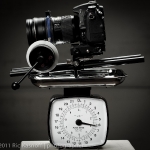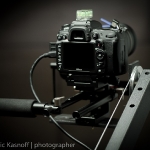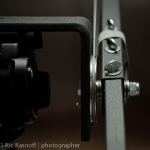CobraCrane Backpacker
When I put out the call for lower priced, travel friendly Jibs (camera cranes) to review for this series I received notes from manufacturers of an assortment of Jibs that were anything but “travel friendly”, a few that blurred the line, and one that was specifically built for the task, The CobraCrane USA “Backpacker”.
I spoke with Rene Kropf, CEO of NetMarket, the US Cobra Crane USA distributor, about a few different compact jibs in their lineup and with his help and advice decided that the “Backpacker” with it’s low cost, size, portability and unique feature set, should be the one I would test and review.
 When the package arrived it was so compact and light I thought something must be missing…until I opened the box. The uniqueness of the single bar telescoping design with a cable driven “manual tilt” that could fit into such a small package immediately peaked my interest. Could this 13 lb featherweight jib actually handle the 6.5 lbs of camera gear that the specs called out and add enough movement to my shots to be worthwhile?
When the package arrived it was so compact and light I thought something must be missing…until I opened the box. The uniqueness of the single bar telescoping design with a cable driven “manual tilt” that could fit into such a small package immediately peaked my interest. Could this 13 lb featherweight jib actually handle the 6.5 lbs of camera gear that the specs called out and add enough movement to my shots to be worthwhile?
Well let’s see…
Setting up the Backpacker was incredibly simple. It arrives fully assembled with the tilt drive cable installed. Three thumbscrews released and allowed the weight bar to be extended from a collapsed 42″ to it’s full 5′ working length, the included Bogen compatible QR plate slipped right into my tripod head and I was ready to start adding the camera and counterbalance weights.
 OK…now I had to figure out what camera/rig to mount so I’m within the 6.5 lb limit…As you may have seen in my other reviews, I like to shoot with a subset of my GenusTech shoulder rig so I can have the Bravo follow focus available for racking and a place to mount a head end guide handle. Because of the Backpackers built in tilt mechanism I was able to leave off the fluid head (701 or 501 depending) that I would normally mount this rig to and save a few pounds… It had been a while since I’ve actually weighed various combinations of my gear so I dug out the scale. My Nikon D7000 with the hefty 24-70mm / 2.8 lens on the FF rig came to a total of 6.25 lbs. Just under the limit so I was OK with what should be the heaviest lens I would probably shoot on it.
OK…now I had to figure out what camera/rig to mount so I’m within the 6.5 lb limit…As you may have seen in my other reviews, I like to shoot with a subset of my GenusTech shoulder rig so I can have the Bravo follow focus available for racking and a place to mount a head end guide handle. Because of the Backpackers built in tilt mechanism I was able to leave off the fluid head (701 or 501 depending) that I would normally mount this rig to and save a few pounds… It had been a while since I’ve actually weighed various combinations of my gear so I dug out the scale. My Nikon D7000 with the hefty 24-70mm / 2.8 lens on the FF rig came to a total of 6.25 lbs. Just under the limit so I was OK with what should be the heaviest lens I would probably shoot on it.
 When set to it’s full 5′ length the Backpacker has a 3′ of boom arm in front of the pivot point and 2′ behind. This translated to a 2.4 to 1 ratio of camera gear to counterweight and I ended up with a total of 15 lbs of standard circular weights and strap-on “tuning” weights to get my initial balance. (note: If trekking with this I’d definitely be bringing my Photoflex water bags or something similar so I wasn’t packing/carrying that weight to remote locations)
When set to it’s full 5′ length the Backpacker has a 3′ of boom arm in front of the pivot point and 2′ behind. This translated to a 2.4 to 1 ratio of camera gear to counterweight and I ended up with a total of 15 lbs of standard circular weights and strap-on “tuning” weights to get my initial balance. (note: If trekking with this I’d definitely be bringing my Photoflex water bags or something similar so I wasn’t packing/carrying that weight to remote locations)
I immediately noticed a difference in the way it felt versus the indiGo jib I had just finished testing. Not a negative difference…just a different way it felt re: the “float”. The indiGo is a slightly heavier jib (14lbs) with dual arm construction and 8 bearing points that give a real sensation of effortless float while the less expensive (about 30% less than the indiGo), slightly lighter build and compact nature of the Backpacker had a “smooth frictionless” feel with it’s dual inline bearings both where the arm connects to the side of the tripod mounting bracket and the camera mount attaches to the top of the boom arm. Another big difference between them is in their overall “bulk”. That can most likely be attributed to the materials (aluminum for the indigo vs steel for the backpacker) used in their construction and allows the Backpacker to be much smaller (backpack-able ;-) than the indigo
 OK…time to rearrange my head and approach this for what it is… It isn’t intended to substitute for a bigger studio crane. (They have many other models for that). It’s a deliberately compact, very easily transportable camera Jib that enables you to add motion and moves to shoots in remote locations without a lot of drama or effort. Period.
OK…time to rearrange my head and approach this for what it is… It isn’t intended to substitute for a bigger studio crane. (They have many other models for that). It’s a deliberately compact, very easily transportable camera Jib that enables you to add motion and moves to shoots in remote locations without a lot of drama or effort. Period.
That being said, I still wanted to run it through my regular close-up and macro test routine to see how she’d do and get more hands-on time with her before taking her out on location and putting it to more of it’s intended use.
When I first start working with it, getting smooth movements required concentration and a very deliberate two-handed (guide and dampening) technique. After a bit of practice my pans, lifts and even my start-stop shots on a dolly track were coming out much nicer and the more macro type moves were becoming more predictable and dependable. Once you understand that with a compact unit like this, the mass and dampening that your hands and body provide are an integral part of a “system” you’ll dial into using it pretty quickly.
On to the “manual tilt” feature…
In the indiGo review I bemoaned the lack of a way to achieve camera tilts without the use of a motorized head or driving from the camera end with a fluid head. With the Backpacker the extra baggage/weight/batteries/cables and “stuff” that come with the motorized or an extra head aren’t necessary. It has a clever cable driven mechanism that works in conjunction with your tripod head to change the angle of your camera either statically or, with some practice, while performing another move.
I suspect that a part of the stated weight limit might be due to this friction driven pulley/cable system (ok I confess…I actually “know” because I overloaded it and it slipped ;-). There’s a definite point where the weight of the camera can overcome the friction of the cable on the pulley. When you stay within the weight limits and balance your camera evenly on the mounting platform it actually works really well and extends the units working range while giving you yet another perspective to see/shoot your subject from. All it takes is coordinating your mind, hands and eyes all doing different things at different resistances at the same time… ;-p
Actually it’s not as hard as it sounds and a bit of practice goes a long way…my “combo” moves are getting longer and smoother in a fairly short time. Video #1, the inside close-up test, shows how using this feature on one of my light test dummies showed dramatic improvement with just 15-20 minutes of practice. So much so I ended that session with a 60mm Nikon macro and was very pleased with the results. You can definitely control this rig and use it for slow small close-up moves..
After practicing/testing inside a little longer than planned due to the wonderful Seattle weather, moving outside and into more of it’s intended environment was welcome and relatively painless. I found it’s compact size a blessing as, unlike other jibs, I was able to leave it at full extension and still easily move it from place to place. Mounting/un-mounting the camera and weights were the only hassles and not really much of one at that. The addition of a QR receiver at the camera end and a water or sand bag to use with location sourced counterweight materials would negate most of that. I’ll be posting video of that test soon.
Though I didn’t get to see or try it, the website indicates that a padded backpack type carry bag is available for the Jib. That would be a nice addition and should definitely add to the ease of safely transporting the unit and any accessories in your vehicle and onto location.
Final note: Be prepared for a learning curve. To fully realize the capabilities and benefits of this very compact/portable Jib you’ll need to invest some time and energy in training your hands and body to take the place of the mass of other jibs. Now this isn’t a negative. The time you’ll invest getting to know this tool will certainly worth it when you’re trying to hit a baggage size/weight limit or hiking up a mountain/in the backcountry where you’ll appreciate the visual interest it’s movements can add to your shots.
Bottom line: Good build quality, reasonably priced at $299.00 (on sale), good customer service and easy to set-up. No it’s not a studio build jib so yes, it will be lighter and have some flex (bigger bearings?). If you’re looking for a compact jib that is tailored to travel and backpacking it definitely should be on the top of your list to check out.
Have fun…Ric
BTW: I had many conversations with Rene from Netmarket/CobraCrane and found him open, outgoing and very responsive to questions and inquiries. (even on holiday weekends ;-) This, coupled with CobraCranes 18+ years of making cranes/jibs bodes well for the type of customer service and support one should expect to get before, during and after a purchase from them.
More info: http://www.cobracraneusa.com/cobracraneIbackpacker.html
Video one is a few samples from my indoor close-up tests. Pans, rises and falls, starts and stops and yes, the tilt feature. Checking for controllability and smoothness out of the box.
Video Two will be posted in a few days as I want to edit in footage from a recent trip to the backcountry.